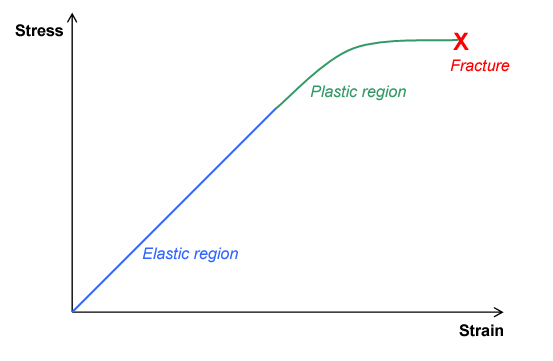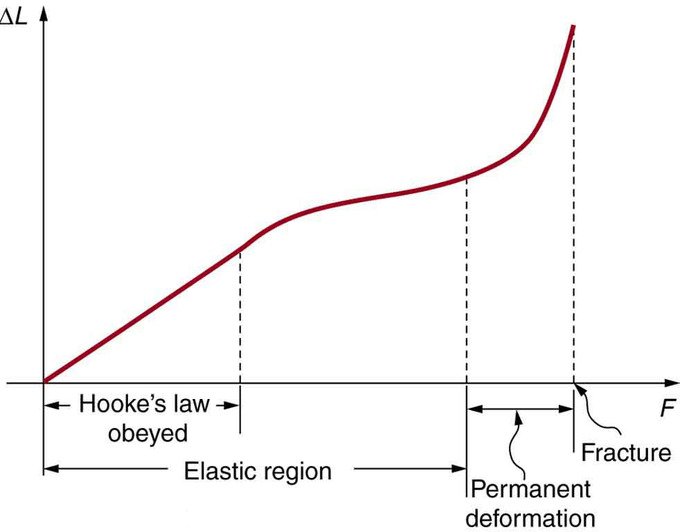Physics - Classical Mechanics - Elasticity and Plasticity of Common Materials

[Image 1]
Introduction
Hey it's a me again @drifter1! I took a break from posting, so that I could dedicate myself to the Master's Degree in Computer Science. I needed a break after the Bachelor thesis and then the Master and COVID-19 quarantine stuff etc. happened and so I never got the time to start posting again. Either way, I am still studying, but there is more free time and so I thought of getting into Steemit and the new fork "Hive" again. I will start out by posting in both platforms, but later I might go Hive-only. Today we continue with Physics and more specifically the branch "Classical Mechanics" to continue with the chapter of Equilibrium and Elasticity. In this article we will get into the Elasticity and Plasticity of Common Materials. Its one of the last parts of the chapter, that should have been done 10 months ago! So, without further ado, let's dive straight into it!
Elasticity
Elasticity is the tendency of solid objects and materials to return to their original shape after some external force caused them to deform. The elasticity of a material is defined through its elastic modulus and elastic limit. High elastic modulus materials are harder to deform, whilst low elastic modulus materials are easier to deform. After a specific elastic limit of stress (force over area) is reached, a material no longer behaves elastically and becomes permanently deformed. For example, a rubber band has low elastic modulus (easily deformed), but a high elastic limit (difficult to permanently deform).Plasticity
For stresses beyond the elastic limit, a material behaves plastically. Plasticity is the state in which the deformation is irreversible. In the so called plastic region the material can no longer return to its original shape and size, even if the load is removed. As the stress increases, a material becomes harder and harder to deform, until it reaches the fracture point where it breaks.Stress-Strain Diagram
The relationship between the stress and strain can be represented on a stress-strain diagram. Each material has its own characteristic curve. On most typical materials as the load increases the relationship is linear up to a elastic linearity point, which means that Hooke's law is directly obeyed. From their the relationship becomes non-linear. Its worth noting that the behavior is still elastic after the non-linear point is reached. The non-linear point occurs before the elastic limit is reached.For example:

[Image 2]
Fracture
There are two types of fractures that can occur on materials after the fracture point of stress is reached. There are fractures that can occur "without warning" causing major damage and are called Brittle Fractures. Then there is Ductile Fracture, which gives some kind of warning that failure is imminent. All fractures involve two steps, the crack formation and the propagation. During a tensile test, Ductile materials show a ultimate strength that is lower than the ultimate tensile strength (UTS) value, whereas in Brittle materials the fracture strength is equal to the UTS. This so called Ductility of Ductile materials allows the material to be alongated in tension, causing them to deform (elongate) more than Brittle materials. Therefore a Ductile fracture is better than a Brittle fracture, as the tension is slowly propagated and absorped before the fracture occurs. In Brittle materials no plastic deformation takes place before the Brittle fracture, which means that the cracks in Brittle Materials are highly unstable and propagating rapidly.Common Materials
The following table shows the Typical properties of Annealed elements.
From Wikipedia remade using quicklatex
RESOURCES:
References
- https://phys.libretexts.org/Bookshelves/University_Physics/Book%3A_University_Physics_(OpenStax)/Map%3A_University_Physics_I_-_Mechanics_Sound_Oscillations_and_Waves_(OpenStax)/12%3A_Static_Equilibrium_and_Elasticity/12.06%3A_Elasticity_and_Plasticity
- https://courses.lumenlearning.com/boundless-physics/chapter/elasticity-stress-strain-and-fracture/
- https://www.nuclear-power.net/nuclear-engineering/materials-science/material-properties/toughness/fracture-of-material-fracture-mechanics/#:~:text=In%20the%20tensile%20test%2C%20the,ultimate%20strength%20at%20this%20point.
- https://en.wikipedia.org/wiki/Ultimate_tensile_strength
Images
- https://en.wikipedia.org/wiki/File:Stress-strain1.png
- https://courses.lumenlearning.com/boundless-physics/chapter/elasticity-stress-strain-and-fracture
Mathematical equations used in this article, where made using quicklatex.
Previous articles of the series
Rectlinear motion
- Velocity and acceleration in a rectlinear motion -> velocity, acceleration and averages of those
- Rectlinear motion with constant acceleration and free falling -> const acceleration motion and free fall
- Rectlinear motion with variable acceleration and velocity relativity -> integrations to calculate pos and velocity, relative velocity
- Rectlinear motion exercises -> examples and tasks in rectlinear motion
Plane motion
- Position, velocity and acceleration vectors in a plane motion -> position, velocity and acceleration in plane motion
- Projectile motion as a plane motion -> missile/bullet motion as a plane motion
- Smooth Circular motion -> smooth circular motion theory
- Plane motion exercises -> examples and tasks in plane motions
Newton's laws and Applications
- Force and Newton's first law -> force, 1st law
- Mass and Newton's second law -> mass, 2nd law
- Newton's 3rd law and mass vs weight -> mass vs weight, 3rd law, friction
- Applying Newton's Laws -> free-body diagram, point equilibrium and 2nd law applications
- Contact forces and friction -> contact force, friction
- Dynamics of Circular motion -> circular motion dynamics, applications
- Object equilibrium and 2nd law application examples -> examples of object equilibrium and 2nd law applications
- Contact force and friction examples -> exercises in force and friction
- Circular dynamic and vertical circle motion examples -> exercises in circular dynamics
- Advanced Newton law examples -> advanced (more difficult) exercises
Work and Energy
- Work and Kinetic Energy -> Definition of Work, Work by a constant and variable Force, Work and Kinetic Energy, Power, Exercises
- Conservative and Non-Conservative Forces -> Conservation of Energy, Conservative and Non-Conservative Forces and Fields, Calculations and Exercises
- Potential and Mechanical Energy -> Gravitational and Elastic Potential Energy, Conservation of Mechanical Energy, Problem Solving Strategy & Tips
- Force and Potential Energy -> Force as Energy Derivative (1-dim) and Gradient (3-dim)
- Potential Energy Diagrams -> Energy Diagram Interpretation, Steps and Example
- Internal Energy and Work -> Internal Energy, Internal Work
Momentum and Impulse
- Conservation of Momentum -> Momentum, Conservation of Momentum
- Elastic and Inelastic Collisions -> Collision, Elastic Collision, Inelastic Collision
- Collision Examples -> Various Elastic and Inelastic Collision Examples
- Impulse -> Impulse with Example
- Motion of the Center of Mass -> Center of Mass, Motion analysis with examples
- Explaining the Physics behind Rocket Propulsion -> Required Background, Rocket Propulsion Analysis
Angular Motion
- Angular motion basics -> Angular position, velocity and acceleration
- Rotation with constant angular acceleration -> Constant angular acceleration, Example
- Rotational Kinetic Energy & Moment of Inertia -> Rotational kinetic energy, Moment of Inertia
- Parallel Axis Theorem -> Parallel axis theorem with example
- Torque and Angular Acceleration -> Torque, Relation to Angular Acceleration, Example
- Rotation about a moving axis (Rolling motion) -> Fixed and moving axis rotation
- Work and Power in Angular Motion -> Work, Work-Energy Theorem, Power
- Angular Momentum -> Angular Momentum and its conservation
- Explaining the Physics behind Mechanical Gyroscopes -> What they are, History, How they work (Precession, Mathematical Analysis) Difference to Accelerometers
- Exercises around Angular motion -> Angular motion examples
Equilibrium and Elasticity
- Rigid Body Equilibrium -> Equilibrium Conditions of Rigid Bodies, Center of Gravity, Solving Equilibrium Problems
- Force Couple System -> Force Couple System, Example
- Tensile Stress and Strain -> Tensile Stress, Tensile Strain, Young's Modulus, Poisson's Ratio
- Volumetric Stress and Strain -> Volumetric Stress, Volumetric Strain, Bulk's Modulus of Elasticity, Compressibility
- Cross-Sectional Stress and Strain -> Shear Stress, Shear Strain, Shear Modulus
Final words | Next up
And this is actually it for today's post!Next time we be getting into Exercises on the various Stress, Strain Types and Elasticity/Plasticity...
See ya! Keep on drifting!